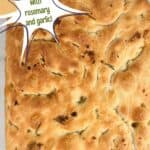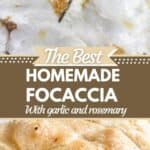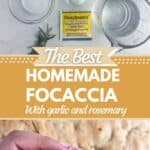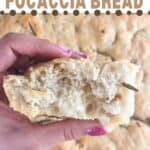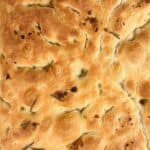The Best Bubbly Focaccia Bread
Focaccia bread is an airy rich bread enhanced with the flavors of olive oil, garlic, and rosemary. Once you try homemade focaccia, you’ll never settle for store-bought bread on Italian night.
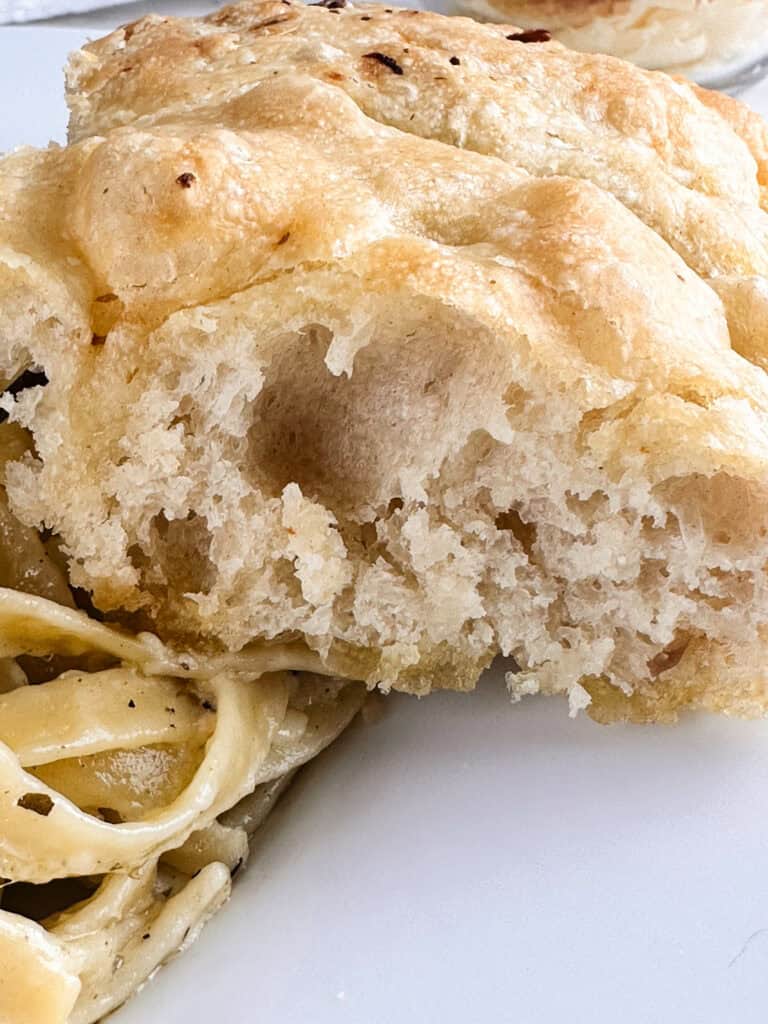
Post may contain affiliate links. As a member of the Amazon affiliate program, I may earn a small commision from qualifying purchases. To read my affiliate policy, click here.
Focaccia is my new obsession.
Not only is it absolutely delicious and something that my daughter begs for, but the whole process of making it is really soothing.
And when the dough rises and makes the bubbles, it is so dang satisfying to jiggle it and say, “Bubbles, bubbles, bubbles! My bubbles!”
For real though.
Because you know those foccacia bubbles are going to create these really amazing air pockets in the dough that lend to the finished bread’s chewy yet light consistency.
If heaven is a bread, it’s this focaccia bread.
It smells amazing and yeilds the best tasting, richest, most satisfying bread ever that is perfect as a side, as a sandwich, or just on its own.
What makes focaccia different from other bread?
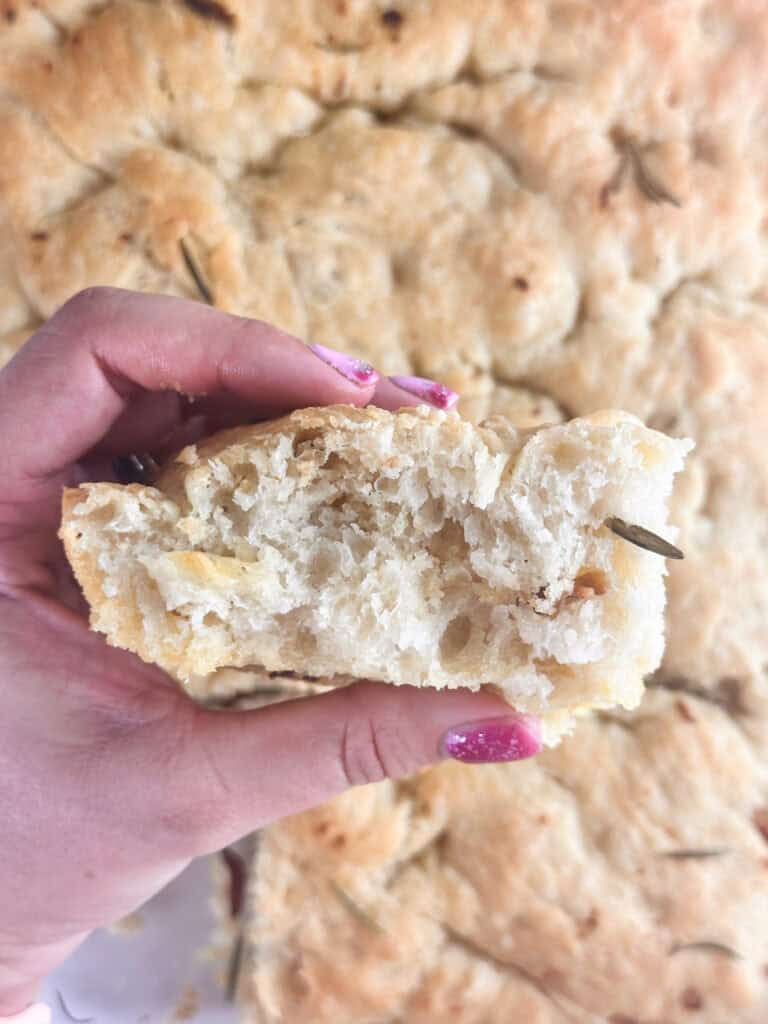
A lot of people think that foccacia is Italian flatbread.
This is definitely not the case, as foccacia, like regular bread relies on yeast for leavening.
Flatbread doesn’t have yeast and as a result has a dense finished product.
Where the confusion comes in is because foccacia dough is so high moisture, it won’t shape into a loaf well.
Instead it gets stretched into a 9×13″ baking dish and the texture and surface is closer to that of deep dish pizza dough.
In fact, sometimes you’ll hear people talk about pizza bread and normally they are talking about foccacia .
Ingredients and Kitchen Supplies
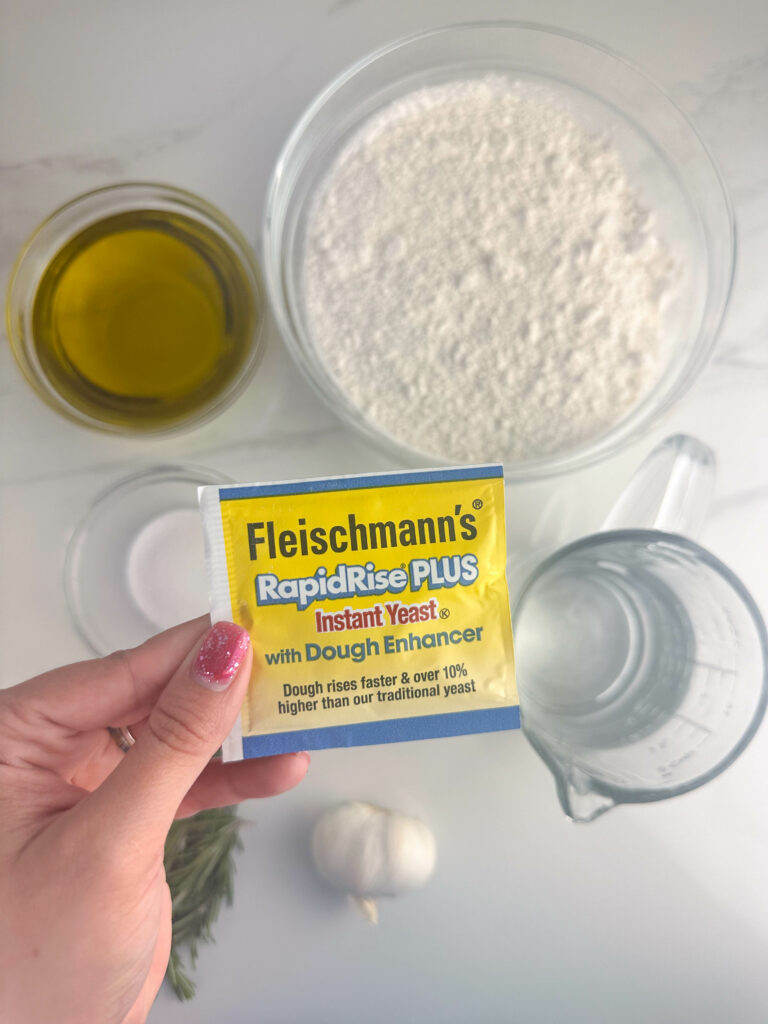
Focaccia may sound fancy, but it uses simple ingredients, many of which you probably already have:
- Bread Flour – You really should use bread flour for this. Focaccia does not come out as well with all-purpose flour.
- Yeast – I have tried a few varieties of this, including Fleischmann’s RapidRise Instant Yeast and Fleischmann’s RapidRise PLUS Instant Yeast with Dough Enhancer. While both work well, I will say the one with the Dough Enhancer really makes some of the best bubbles that you need for focaccia.
- Water – Water that’s warm to the touch but not hot to activate the yeast.
- Garlic – You’ll need a few cloves of fresh garlic, crushed or diced.
- Fresh Rosemary – You’ll need a sprig or two of fresh rosemary.
- Olive Oil – You can use regular olive oil or extra virgin olive oil.
- Sugar – The sugar helps to proof the yeast and make sure it is ready to use.
- Salt – I use coarse sea salt, but you can use regular table salt.
Kitchen supplies you’ll need include:
- kitchen scale
- a stand mixer with a dough hook
- measuring cups and spoons
- a pastry brush
- a second large mixing bowl
- 9×13 baking dish
How to Make Focaccia Bread
Focaccia bread takes a few steps, but most of the time spent on the bread involves rise times.
Your active time is about 30 minutes total.
1. Proof the yeast and mix the dough.
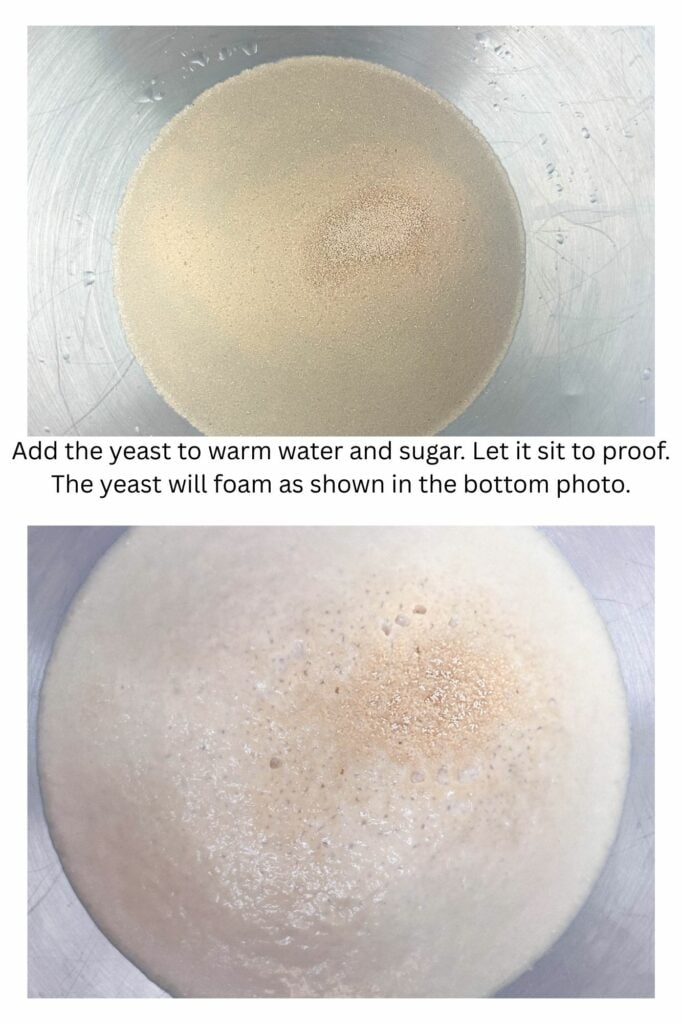
Use lukewarm to slightly warm water and pour into the bowl of your stand mixer.
Stir in the sugar and then add the yeast.
Allow the yeast to sit for about 5 to 10 minutes.
If it starts to foam, it is ready and active.
If it doesn’t, you’ll want to toss the water and yeast and start over with a fresh packet of yeast.
Once you proof your yeast, add in the salt and flour.
Use a dough hook and mix the dough for 5 minutes on medium speed.
After 5 minutes the dough will be very elastic and sticky but will sort of pull away from the sides of the bowl.
It will form a thick, sticky dough that will stick to the sides and most everything that touches it.
2. Make the garlic rosemary olive oil.

In a small sauce pan, heat the olive oil, garlic, and rosemary over low heat.
I like to start this while proofing the yeast and let it slowly simmer while the dough kneads.
Take it off the heat when the garlic is fragrant and the rosemary starts falling off the stem.
This normally happens right around when the dough is done kneading.
3. The First Rise
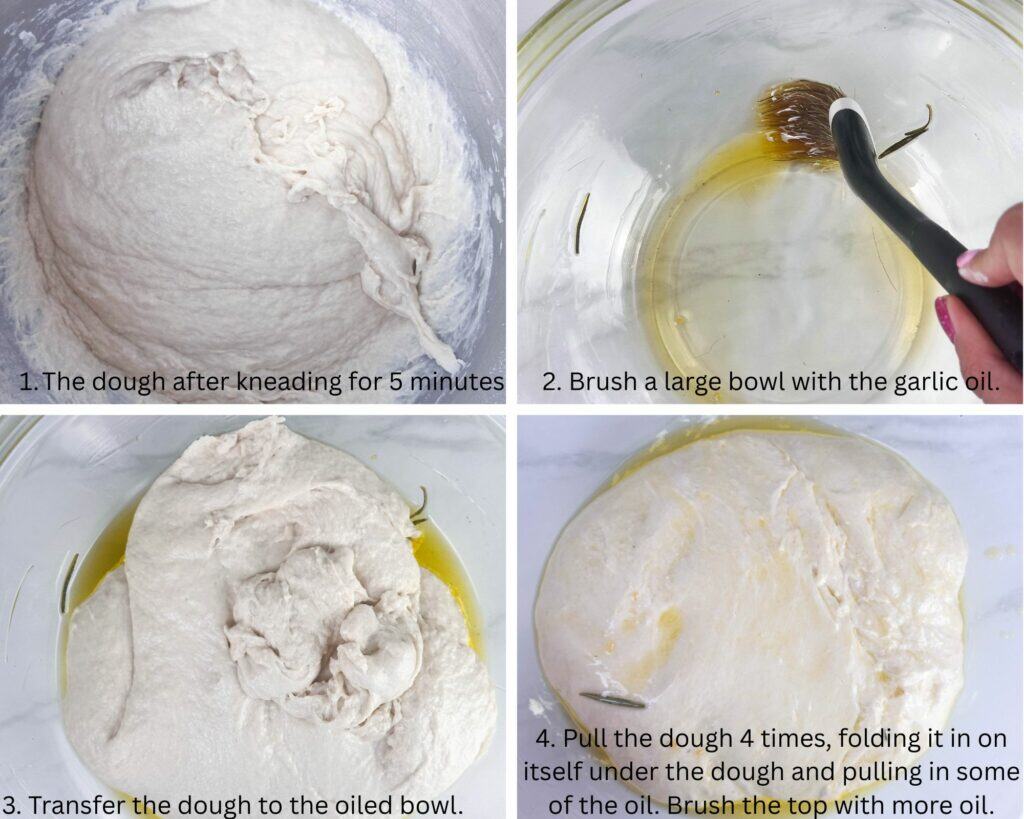
Brush twoish tablespoons of olive oil on the bottom and up the sides of a large mixing bowl.
Pour the kneaded dough out of the mixer, using a sturdy spoon to help you transfer it.
The dough will be too sticky and too wet for you to transfer it with your hands.
After the dough is transfered, mentally divide the dough into a square.
With olive oiled hands, pull one corner of the square out away from the center of the square.
Then fold it in towards the diagonal opposite corner.
Repeat this with each corner for 4 stretch and pulls.
The dough should be smooth and almost silky at this point, with some of the oil folded into it.
If it’s not, do another 2 to 3 stretch and pulls.
Cover the bowl with foil or a towel and let the dough rise for at least 90 minutes or until it doubles in size and gets bubbly.
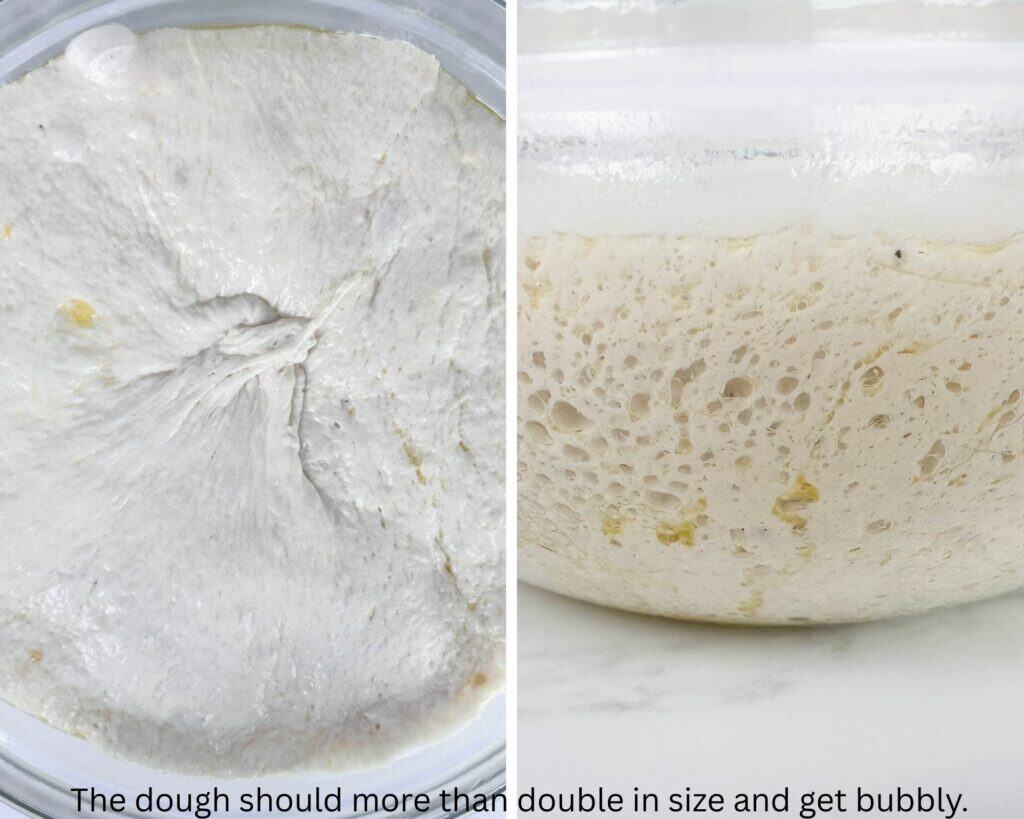
3. Transfer the Dough to Greased Baking Pan (The Second Rise)
Brush another 2ish tablespoons of the garlic rosemary oil on the bottom and up the sides of a 9×13 baking dish.
Pour the risen dough into the prepared baking dish.
Use oiled fingers to gently pull and stretch the dough towards opposite corners in the baking dish until it covers the dish.
Cover the dish and let the dough to rise again in the baking dish for another 45 minutes to hour or until the dough doubles in height and big bubbles form.
4. Dimple the dough and bake.
Set your oven to 425 degrees.

As the oven heats, gently push the dough down with your olive oiled fingers, forming pockets in the dough.
Though it’s super tempting, do not pop the bubbles.
Let the dough rest for a few minutes while the oven finishes preheating and then very carefully and gently brush some of the garlic oil on top.
Bake the focaccia for about 20 minutes or until it reaches a golden brown on top.
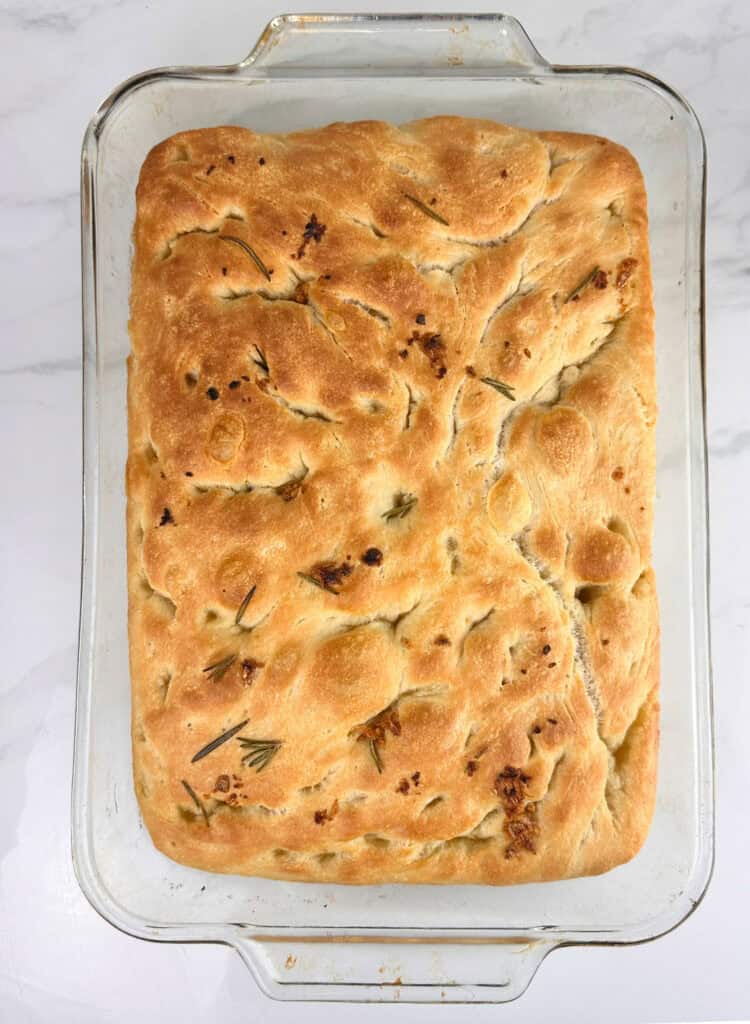
Let it cool for a few minutes before serving fresh from the oven.
Sprinkle with extra flakey sea salt or parmesan cheese if desired.
Enjoy!
Storing
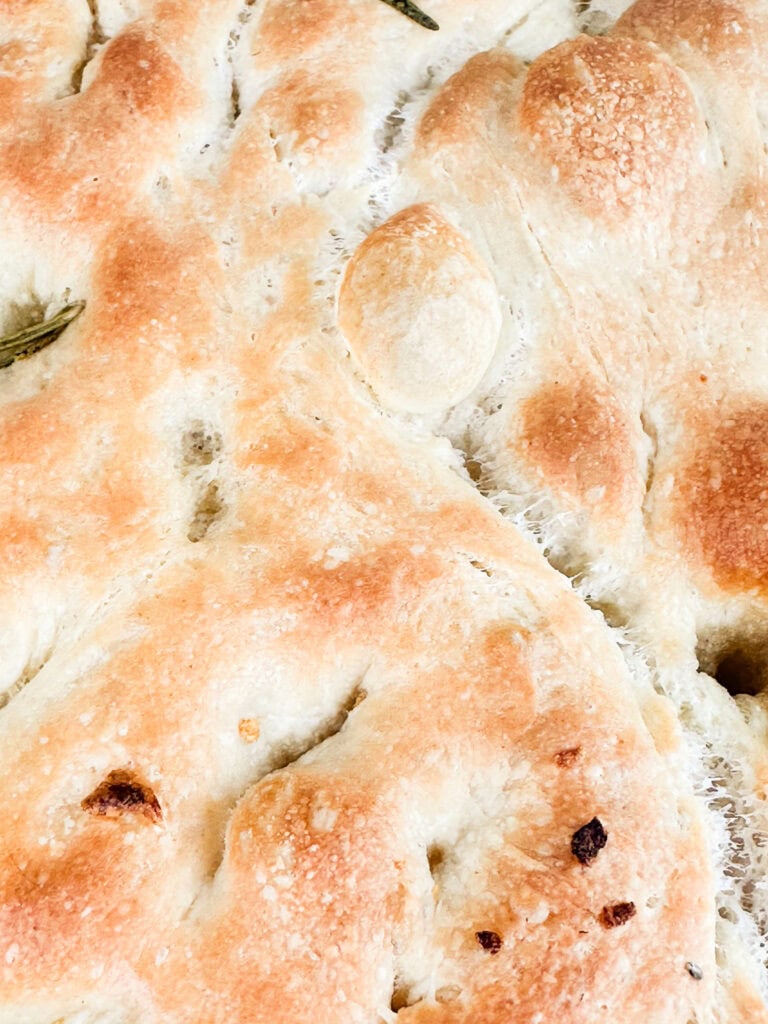
Focaccia bread stays fresh for several days on the counter.
To store, cut into smaller pieces and place in an airtight container.
You can also cover tightly with plastic wrap.
Focaccia should say fresh for about 2 to 3 days without refrigeration.
You can serve leftovers as bread for sandwiches and paninis, as a savory side, or as a base for one of the best homemade pizzas you have ever had.
What Kind of Flour for Focaccia Bread
I have tried this recipe three different ways:
- using only all purpose flour
- with all bread flour
- and with half all purpose and half bread flour
The best results are always from using bread flour because of the higher protein content.
Bread flour’s higher protein content gives the focaccia dough a little more structure for those beautiful bubbles to form and makes for a chewier finished product.
When made with all purpose flour, the focaccia bread will turn out softer but won’t have the same amount of light and airy bubbles throughout which makes a big difference in the finished product.
Judging Focaccia Dough
My hubs and I often talk about how baking is a science and cooking is like an art.
But in focaccia’s case, baking becomes more of an art and this sounds a little wackadoo but you have to learn to let the dough talk to you and listen to it.
I have made this recipe dozens of times this year trying to perfect it and I use feedback from the dough to make it.
For example, the 5 minute kneading time in your stand mixer is a guideline. The dough will visibly but subtley change when it is ready, going from sort of shaggy to smooth and sticky.
The olive oil guidelines are estimates. I do always start with around 2 tablespoons, but sometimes I add more if the dough isn’t elastic enough, if the dough absorbs more, etc.
When you do the stretch and folds, the garlic oil gets folded into the dough and makes the dough even more smooth, elastic, and a bit less sticky.
As for rising, again the 90 minutes is a starting off point.
You want it to rise at least 90 minutes, but the dough is ready to move to the second rise when it gets bubbles around the top. Generally the longer you leave it sit and rise, the more it will bubble.
You may find the dough is nice and bubbly after 90 minutes, especially if it is in a warm environment or if you are making this in the dead of winter, might find that 90 minutes isn’t enough.
The same is true of the second rise.
In general the more bubbles and the more the dough jiggles in the pan, the better for baking the bread.
And that’s how you judge ficaccia dough’s readiness to bake.
You can see more in this video all about how to proof focaccia dough.
What to Serve with Focaccia Bread
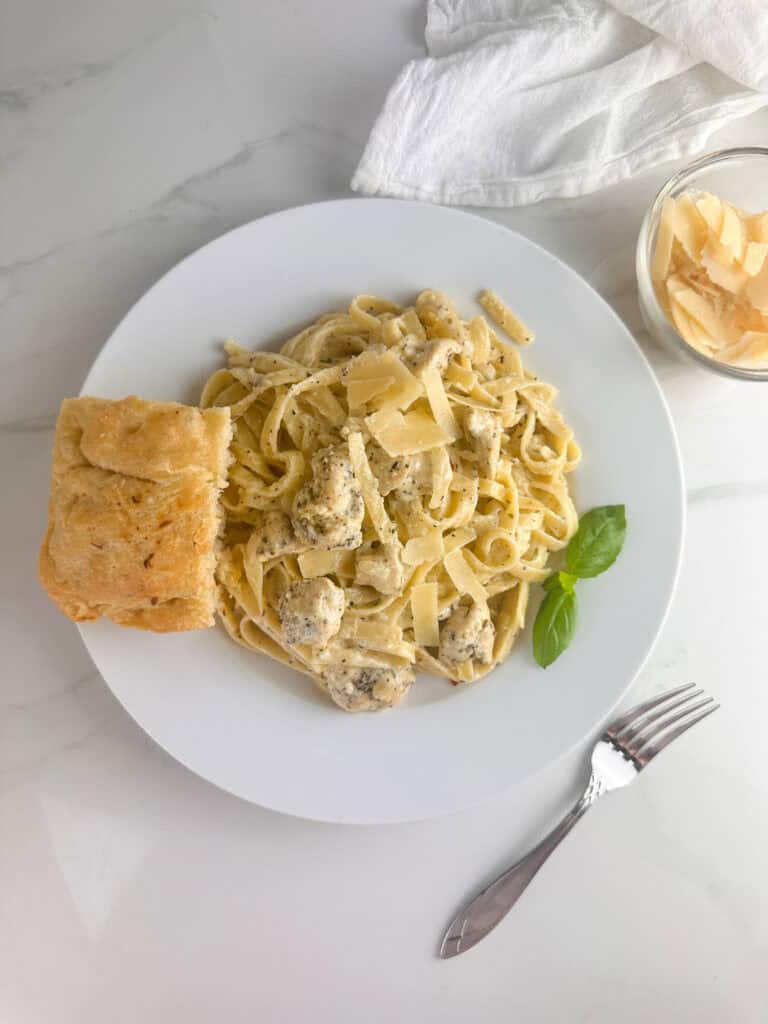
If you don’t plan to make sauce to serve with your focaccia bread, you are doing yourself a huge disservice.
You can try this authentic tomato sauce or pesto, either of which makes the perfect dipping sauce for focaccia.
You can also serve these with homemade meatballs, spicy meatballs, or store bought meatballs.
And of course, it is yummy with pastas, like chicken pesto pasta, creamy chicken and pasta gnocchi, or pasta with pesto.
Tips and Tricks
- You do not have to use the garlic rosemary olive oil if you don’t want and can just use regular olive oil. I do highly recommend it for the added flavor.
- Let’s talk toppings for a minute shall we? With the garlic rosemary olive oil, there’s a lot of flavor. But you could also top it with roasted garlic, sun dried tomatoes, olives, etc. And a sprinkle of Parmesan cheese is never not a good thing!
- DO. NOT. POP. THE. BUBBLES. This dough isn’t bubble wrap. You want all those bubbles for textures and airiness. I know it’s tempting but BACK AWAY FROM THE BUBBLES. You, there. Yes, you. I see you, don’t do it.
- Don’t try to speed up the rise process. I have tried by putting it in the oven on the proof setting. It doesn’t yeild great results. The dough dries out and doesn’t get the beautiful bubbles that you definitely should not pop.
- When it doubt, put olive oil on your hands. This dough is very sticky. Oiling your hands will help making working with it easier.
- Speaking of olive oil, you will have leftover garlic rosemary olive oil. Store the leftovers in a sealed jar in your fridge for up to a few weeks and use it in another loaf of foccacia, as bread dip, or to cook with.
- Don’t want to have it in a sandwich or as a side dish? Use it to make focaccia bread pizza.
Did you make this? Let me know!
Did you make this focaccia bread recipe or any other recipe on my site? Leave me a comment below and let me know how you liked it.
Make sure you follow along with me on Facebook, Pinterest and Instagram to see everything we’ve got going on.
Stay in the know! Sign up for our newsletter that contains the latest recipes and tips.
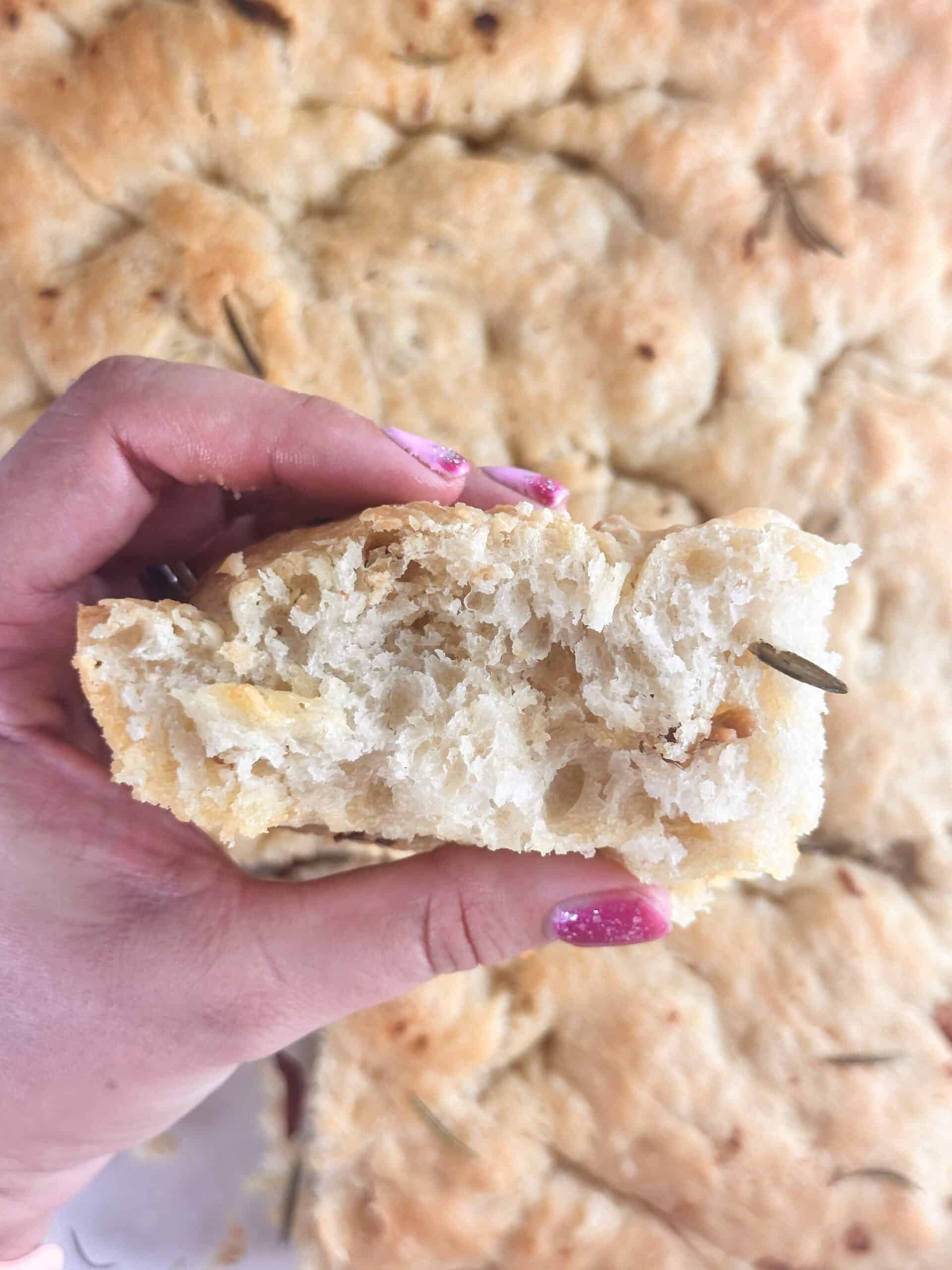
Equipment
- 1 Stand Mixer with dough hook Highly recommend the dough hook and standmixer since the dough is very sticky.
- 1 kitchen scale Highly recommend for getting accurate flour measurements.
Ingredients
- 1 3/4 cups warm water 105° to 115°F
- 2 teaspoons granulated sugar
- 2 1/2 teaspoons dry active yeast (preferably with dough enhancer) or 1 (¼-ounce) package active dry yeast
- 525 grams bread flour (or 4 cups plus 3 tablespoons)
- 2 teaspoons sea salt
- 1/2 cup extra-virgin olive oil, plus more for your hands
- 1 sprig fresh rosemary
- 4-5 cloves garlic minced
Instructions
- Add warm water and sugar to the bowl of your stand mixer with dough hook and stir to dissovle the sugar.
- Pour in the yeast, cover, and proof for about 5 to 10 minutes. The yeast is good if it starts to foam, otherwise you'll need to start over with fresh yeast.
- Once the yeast proofs, add in the flour and salt. Mix to combine into a sticky dough. This will take about 5 to 10 minutes.
- Prepare a large mixing bowl by spreading additional olive oil around the bowl. Pour the dough into the prepared bowl.
- Roughly divide the dough into four sections using your eyes. Pull and fold the dough with your hands 4 times starting at opposite corners.
- Cover the bowl and let rise for at least 90 minutes or until the dough has doubled in size and become bubbly.
- Prepare the olive oil, garlic, and rosemary in a small sauce pan. Heat over medium low heat until the rosemary leaves start to come off the twigs, stirring occassionally. This takes about 10 minutes.
- Once you have pulled the bread, place the dough into an olive oil greased 9×13 glass baking dish.
- Gently pull the dough until it reaches all four corners.
- Dimple the dough gently with your fingers and cover.
- Allow to rise for abotu 45 minutes.
- Preheat your oven to 425 degrees F.
- Use a brush or spoon to carefully spread the olive oil, garlic, and rosemary over the top of the focacca dough. Remove any large twigs.
- Let it sit for about 10 minutes with the olive oil mix on top.
- Bake in the preheated oven for about 20 minutes or until the top of the bread is a beautiful golden brown.

